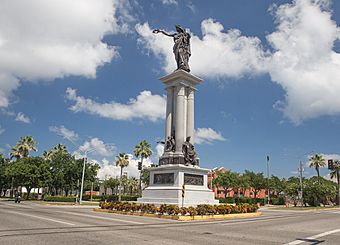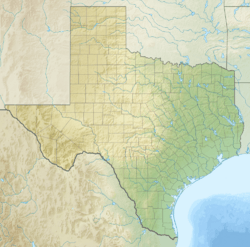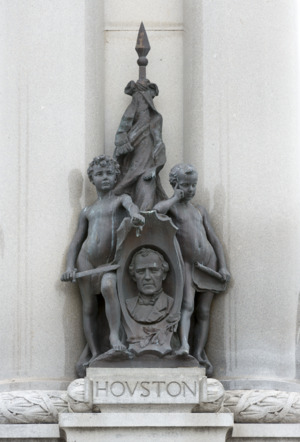Texas Heroes Monument facts for kids
Quick facts for kids |
|
|
Texas Heroes Monument
|
|

Texas Heroes Monument in 2020
|
|
| Location | Broadway St. at 25th St. Galveston, Texas |
|---|---|
| Area | less than one acre |
| Built | 1900 |
| Sculptor | Louis Amateis |
| Architectural style | Beaux-Arts |
| MPS | Central Business District MRACentral Business District MRA |
| NRHP reference No. | 84001737 |
| Added to NRHP | August 14, 1984 |
The Texas Heroes Monument is a special statue in Galveston, Texas. It was built to remember the brave people who fought in the Texas Revolution. This was a big fight for Texas to become independent.
A man named Henry Rosenberg asked for the monument to be built. It was made by New England Granite Works. They used granite from Concord, New Hampshire, and bronze. The monument cost $50,000. It was finished and sent to Galveston before June 4, 1899. The artist who designed it was Louis Amateis. You can find it where Broadway and Rosenberg Avenue meet. The monument was officially shown to the public on April 22, 1900.
Contents
Who Was Henry Rosenberg?
Henry Rosenberg was a very rich banker. When he passed away, he left a lot of money for public projects. He set aside $50,000 specifically for this monument. He wanted it to honor the heroes of Texas's fight for freedom.
The town of Rosenberg, Texas, is named after him. Henry Rosenberg also helped pay for other important buildings. These include the Galveston Orphans Home and the Rosenberg Library. He truly cared about his community.
Meet Louis Amateis, the Sculptor
Louis Amateis was the artist who created the Texas Heroes Monument. He was a professor in Rome, Italy, at the time. When he designed the statues and bronze parts, he had to show his work to the College of Sculptors in Rome. They had to approve his designs before he could make them.
What Does the Monument Look Like?
The monument is mostly made of light gray granite. It also has a bronze statue and bronze pictures called reliefs. The whole monument is about 74 feet (22 meters) tall. This includes the statue of Victory on top.
The bottom part of the monument is 34 feet (10 meters) wide. The main part of the monument has four tall columns. Each column is made from a single piece of granite. These columns are 50 feet (15 meters) high. At the very top of the columns, you can read words. These words describe the qualities of the Texas heroes: Patriotism, Honor, Devotion, and Courage.
The statue of Victory is 22 feet (6.7 meters) tall. She holds a sword wrapped with roses. Her right hand reaches out, holding a crown of laurels. This crown is a symbol of victory and honor.
Patriotism Column
This column faces north. It looks out over the entrance to Galveston. At the bottom of this column, there's a bronze picture of Sam Houston. He is surrounded by figures that represent peace and war. Below Houston are pictures of five other important men: Henry Smith, Edward Burleson, Benjamin Milam, James Fannin, and James Bonham.
On the monument's base, below this column, is a bronze picture of the Battle of San Jacinto. This was the final battle of the Texas Revolution. Underneath all of this, it says: "A Tribute from Henry Rosenberg to the Heroes of the Texas Revolution of 1836."
Courage Column
This column faces east. It has a statue of a woman. She is pulling a sword from its holder. She looks like she is telling the Mexican army to leave Texas. This figure is called Defiance. Below her, you'll see the date October 2, 1835. This date is important because it was the day of the Goliad Massacre. A bronze picture on the monument's base shows this event.
Honor Column
This column faces west. It features a bronze statue of a woman who represents Peace. At her feet are the names of heroes whose photos were not available. These names include Neill, Hockley, Karnes, and de Zavala. Below her, you'll find the date April 21, 1836. This is the date of the Battle of San Jacinto. A bronze picture below the date shows Santa Anna surrendering to Sam Houston after the battle.
Devotion Column
This column faces south. It has a round medal-like picture of Stephen F. Austin. Around him are other important figures. These include David Burnet, Davy Crockett, Frank Johnson, "Deaf" Smith, and William Travis. Below this, there is a bronze picture that remembers the fall of the Alamo.
Heroes Remembered on the Monument
The monument honors many brave individuals who played a part in Texas's history. Here are some of the specific heroes remembered:
- Stephen F. Austin
- James Bonham
- Edward Burleson
- David Burnett
- Davy Crockett
- James Fannin
- George Washington Hockley
- Sam Houston
- Henry Wax Karnes
- Frank White Johnson
- Benjamin Milam
- James Clinton Neill
- Erastus "Deaf" Smith
- Henry Smith
- William Barrett Travis
- Lorenzo de Zavala




